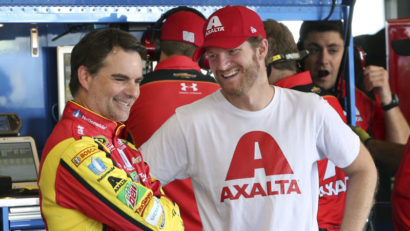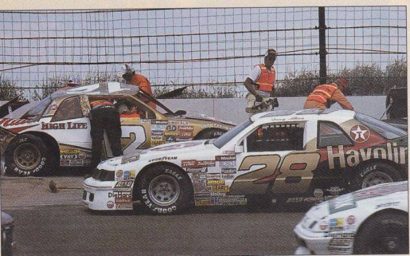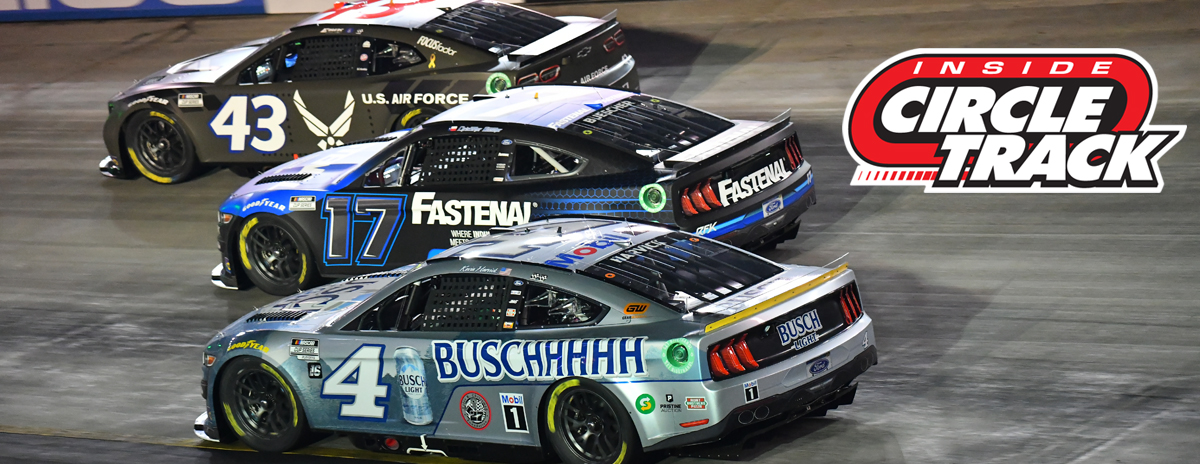
Richard Petty, Bobby Allison and Darrell Waltrip raced passed the age of 50(Photo by Sam Greenwood/Getty Images)
Richard Petty: 54-years-old
Darrell Waltrip: 53-years-old
David Pearson: 51-years-old
Bobby Allison: 50-years-old
Cale Yarborough: 49-years-old
The names listed above are members of the NASCAR Hall of Fame with the ages at which they left the sport listed beside each. As can be seen, these legendary figures remained active in racing in either a full-time or part-time manner into their late 40’s and even into their 50’s. Granted, some of them may not have been terribly competitive late in their careers, but others were. Nonetheless, they were still a part of the sport for multiple decades.

Jeff Gordon and Dale Earnhardt, Jr. retired from racing in their early 40’s.(AP Photo/Mel Evans)
Carl Edwards: 36-years-old
Kasey Kahne: 38-years-old
Dale Earnhardt, Jr: 42-years-old
Jeff Gordon: 44-years-old
Tony Stewart: 45-years-old
As the reader will no doubt recognize, the names listed above this paragraph as those of modern-era NASCAR racers and the ages at which they have left or are leaving the sport. There is a marked difference in the ages. Star drivers of the current era do not seem to hang around as long as their predecessors which may provide them with the opportunity to go out on top but also leaves fans and media members to wonder if they could have won even more races had they remained.
There obviously have to be reasons for these seemingly early departures from what many followers of racing would consider to be a “dream job”. Further, some of these drivers may have left significant amounts of money in the form of contracts and endorsement deals on the table by walking away as they have.
Here are five reasons why this writer believes NASCAR drivers retire at younger ages now as opposed to the previous generations of racers:
Greater Knowledge of Long-term Injury Risks: One thing that almost certainly has to weigh on the minds of race car drivers in the modern era is the risk of serious injury that could impact their quality of life after retirement. The amount of information that is now out there regarding the risks posed by concussions and other injuries over the long-term is significant. Certainly, drivers of the by-gone era of the sport were far less aware of the threat of the potentially crippling side effects of crashes sustained over the course of a long racing career.
Dale Earnhardt, Jr. eluded to this at the time of his retirement when he pointed out that he wanted to go out on his own terms rather than be forced out because of health related issues.

Bobby Allison was badly injured in this Pocono crash.
With the research now being done on sports-related injuries, especially head injuries, this has to be a concern for for those who take part in an activity that features cars going as fast as 200mph within inches of each other on tracks surrounded by albeit SAFER, but still, hard walls.
Bobby Allison, one of the legendary drivers mentioned above, was not as lucky as those who have called it quits earlier in life. The 1983 Cup Series champion suffered career ending injuries that left him with “terrible, terrible memory loss” when he slammed into the outside wall at Pocono Speedway in 1988.
At the time of his retirement, Carl Edwards made mention of the fact that he was happy to be leaving the sport with his health intact. Whether spoken or unspoken, others are likely thinking the same thing.
Too Much Wealth to Take Risks: This writer is not going to begrudge anyone for making money. And at the same time, it is understandable that when someone has accumulated vast wealth they would want to have the opportunity to enjoy and to use it for the good of others.
The NASCAR drivers of today make extraordinary amounts of money while the older stars listed above were often racing simply to make a living, especially during the early parts of their careers. Unlike those from yesteryear, the current generation of racers, even those who typically can be found in the middle of the pack(provided they are not trying to fund their own teams), are hardly living from paycheck to paycheck.
The website NetWorthPost.org lists Dale Earnhardt, Jr. as having a net worth of $400 million with Jeff Gordon coming in at $220 million. Tony Stewart($70 million), Carl Edwards($80 million), and Kasey Kahne($50 million) are far from pauper status. Being that I have not seen the tax returns of these drivers, I will take those numbers with a grain of salt. But without a doubt, each of those listed is worth more than most average folks can imagine.
In comparison to Dirt Late Model racing, where the amount of money available is not nearly so great, NASCAR drivers are retiring at an age when they could still be very competitive. Billy Moyer at 60-years-old and Scott Bloomquist at age 54 are still winning some of their version of the sport’s biggest events. But their net worth is likely not measured in the hundreds of millions, which provides them with incentive to continue at a high level.

A view inside the Jeff Gordon Children’s Hospital
So why keep racing, and risking serious injury, after a very comfortable lifestyle that would also allow one to help others through charitable efforts has been achieved? That is a question some modern-day stars seem to be answering with their actions.
Jeff Gordon cited his work in assisting children with cancer in his retirement announcement by saying, “Outside the race car, my passion is pediatric cancer research, and my efforts will remain focused there when I’m no longer driving.”
Difficulty in Obtaining Sponsors: With NASCAR’s sagging attendance and lowered television ratings almost certainly among the reasons, finding sponsorship has become an increasingly difficult chore for race teams. As a result, drivers who can bring the dollars with them are likely to find rides whereas drivers who cannot are more likely to loose them.
Corporations able to afford the type of advertising budgets needed to back a NASCAR organization seem more likely to put their capital behind drivers who appeal to the coveted marketing demographic of those aged 18 to 34. Those drivers who appeal to that crowd are probably not going to be veteran campaigners over the age of 40.
Two examples of this scenario could include Monster Energy NASCAR Cup Series champions Matt Kenseth and Martin Truex, Jr.
Kenseth, then 45 years of age, was not re-signed by Joe Gibbs Racing at the end of the 2017 season because the No. 20 Toyota he had driven for five seasons would not have been fully funded, including a driver’s salary suited for someone with Kenseth’s list of accomplishments, if he were to be behind the wheel.
Truex is the reigning Cup Series title holder yet his future is currently uncertain as his Furniture Row Racing team has not yet secured full sponsorship for 2019 and beyond. The driver considered to be one of the Big-Three in this current season, along with Kevin Harvick and Kyle Busch, will have his contract expire at the end of this year and no definite plans on the horizon for the 38-year-old.
Teams have seemingly laid much of the responsibility for finding funding on the drivers. Those with more years behind them in the driver’s seat than in front of them may not necessarily be in the mood to play the corporate games that their younger and more hungry competitors are willing to play to obtain those funds.
NASCAR’s Ever Changing Rules Packages: The way NASCAR champions are determined and the way the races are conducted are ever changing from one season to the next. The NASCAR Playoffs(previously the Chase) has undergone multiple “adjustments” since its inception in 2004. And beyond that, a number of innovations such as stage racing and various aerodynamic and other rule changes have created an atmosphere of uncertainty among fans and competitors alike.
Could it be that veteran drivers who have already accomplished much of what they set out to do consider it too much trouble to keep up with all the changes?
Drivers Have Discovered Life Outside of NASCAR/Season is Too Long: And finally, NASCAR drivers apparently have discovered that there is life outside of NASCAR. A grueling 36-week racing schedule that requires what equates to months away from home and family have to take a toll. Often wives and children have to be left behind as the driver/husband/dad goes away to spend a weekend at Pocono, or Phoenix, or Dover, or any other racing locale.
Kasey Kahne’s recent retirement announcement included the popular star’s desire to spend more time with his son. NASCAR Xfinity Series veteran Elliott Sadler cited his plans to coach his son’s sports teams as part of his reason for hanging up his helmet.

Tony Stewart owns Eldora Speedway
And more, some drivers have interests outside of the NASCAR realm. Kyle Larson(25) has recently said that he hopes to be racing full-time on the World of Outlaws Craftsman Sprint Car Series by the time he reaches 40 years of age. Tony Stewart also spends much of his time racing Sprint Cars while also owning the famed Eldora Speedway dirt track. Dale Earnhardt, Jr. and Jeff Gordon have each made their way to the television broadcast booth for half of each racing season.
There is life outside of those motor homes the drivers live half of their lives out of and many of them seem to have decided to take advantage of that while they still can.
A sport that used to see its biggest stars continue to compete well into their 40’s and even their 50’s is now seeing its top names walk away in their late 30’s or their early 40’s. For better or worse, this seems to be the new reality in a sport that offers the chance of long-term injury, pays its participants very well, requires tremendous outside funding, changes its rules frequently, and schedules a very long season.
Richard Allen is a member of the National Motorsports Press Association
Respond to this piece on Twitter –> @RichardAllenIDR
or on Facebook –> InsideCircleTrack/Facebook
